
views
X
Trustworthy Source
American Society for the Prevention of Cruelty to Animals
Leading organization dedicated to the prevention of animal cruelty
Go to source
It will take some time and patience, especially if the animals are older and have never been introduced to each other. But with a little work, your dog can be trained to stop chasing cats, giving you a happy household.
Veterinarian Pippa Elliott MRCVS suggests:"Plan ahead and well in advance of the meeting, work on obedience training the dog. Teaching a rock solid sit and the dog to "Look" will help you diffuse tense situations where the dog might otherwise give chase."
Introducing Your Dog and Cat to Each Other

Choose an appropriate place. It's best to introduce the pets in your home. Bringing a dog to meet a cat at an animal shelter or vice versa may be extremely traumatic, particularly for the cat. For this reason, most animal experts recommend introducing your pets at home.
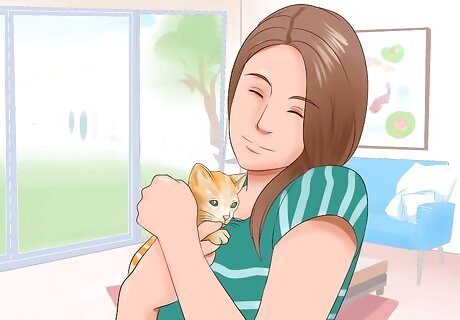
Choose a new pet that will fit with your old pet. If you're bringing home a cat to a home that's always been a dog's home (or vice versa), chances are the dog will be more likely to chase the cat, and the cat will be more likely to antagonize and even attack the dog. If you're adopting a new pet to live at home with an existing pet, ask the staff at the shelter or adoption office whether they have any cats that will get along with dogs or dogs that will get along with cats, as the case may be. This way you know that bringing home your new pet will be more of a minor adjustment period, rather than an agonizing project.
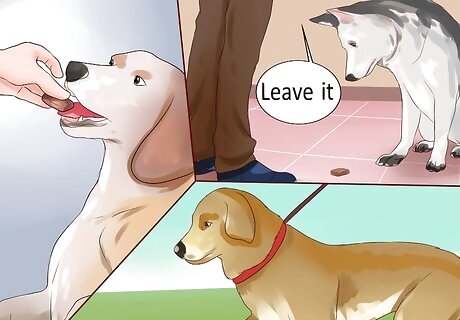
Keep the meeting stress-free. Though it may be difficult to make the introductions a relatively stress-free occasion, it's important for the wellbeing of both animals. Some basic training and reward reinforcement can go a long way towards getting your two pets acquainted. Use treats for both the cat and dog. Choose treats that you know each animal will enjoy, though cats may be more picky. Try tuna or chunks of chicken as a desirable treat for your cat. Train your dog, or refresh his training, on key goals like learning to stay, come on command, and "leave it". This training should be done before your bring home a cat, or before you bring the dog home to a cat, as it will be crucial in getting your dog to disengage when he begins to chase or pester your cat. Especially focus on teaching the dog a recall command, so they'll come back to you when you call. Take your dog running or let him run around a fenced-in yard before introducing the cat and dog. This will help take some of the energy out of your dog, making him less likely to chase the cat during their introduction.
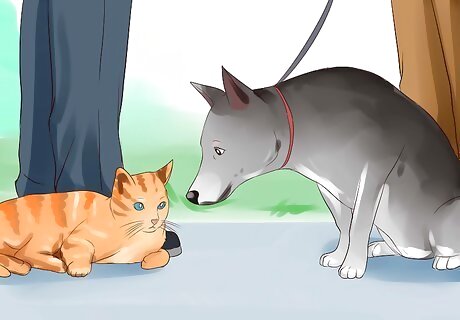
Introduce the two animals. This should be done under strict supervision. Keep your dog on a short leash, and if they seem like they want to chase the cat, keep both cat and dog distracted by feeding them their respective treats. It may be helpful to have a second person in the room, so that you can focus on one animal while the other person focuses on the other animal. Consider introducing them at a distance first, or use a barrier like a baby gate or a glass door to keep the animals separated. If the dog looks at the cat but stays sitting, give the dog a reward. Repeat this process, bringing the dog closer as it grows more comfortable. Allow the animals to sniff each other. You don't want to keep them on opposite ends of the room; aim to merely act as intermediary, in case either animal becomes aggressive.
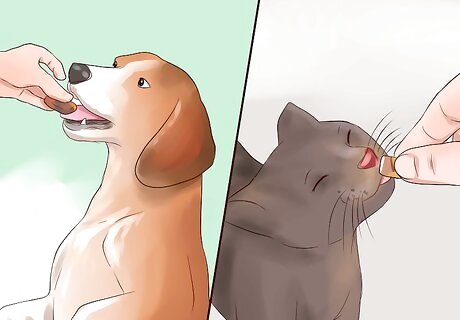
Give them both praise. If both animals are behaving well, give them verbal praise, pet them, and give them extra treats. Going forward for the first few weeks, you may want to continue praising the animals whenever they behave calmly around one another.
Teaching Your Dog to Leave It

Hold a treat in each hand. Only let your dog sniff one hand. They will most likely become excited when they realize that the treat is for them, but it's important to ignore their attempts at getting the treat.
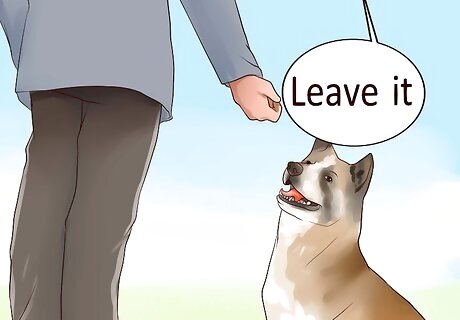
Say "Leave it." The most important part of this exercise is to ignore your dog until they stop actively trying to get the treat. Keep saying "leave it" until they respond to your command. It may take a moment, but eventually the dog should give up and sit in front of you.

Praise and reward your dog. Once your dog has stopped pursuing the treat they knew you had, say "good dog," and give them the treat from your other hand. It's important that you not give your dog the treat used when you say "leave it," as this will only teach your dog that they will eventually get whatever you tell them to leave.
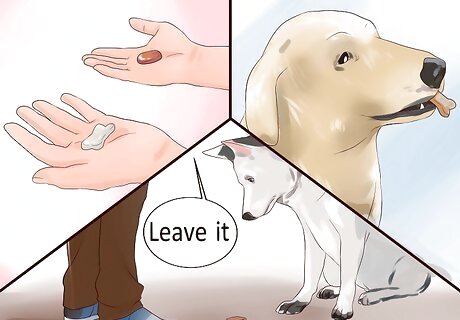
Repeat the process. It's important to be consistent in your training. Repeat the process until your dog immediately backs away from your hand when you tell them to leave it.
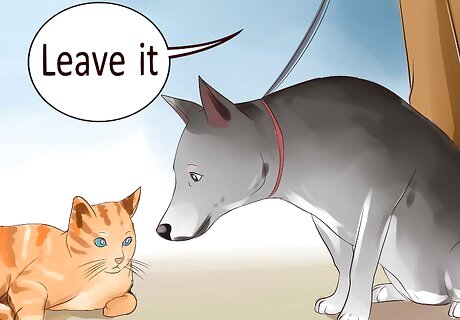
Begin using "leave it" around your cat. Once your dog has mastered the "leave it" command, you can begin to use that command around your cat. You should still be cautious and supervise both animals, as your dog may have learned to leave a treat but may be less willing to leave something they perceive as prey. Be patient, and continue training until your dog learns to leave the cat alone on command.
Using Clicker Training on Your Dog
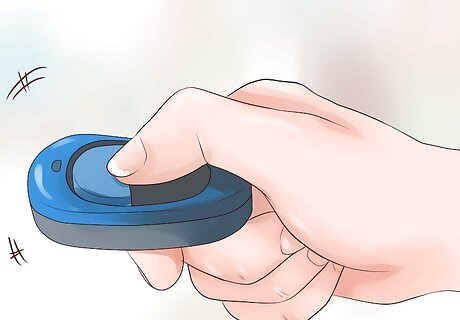
Buy a training clicker. A clicker is a small plastic "box" with a retractable metal tongue, which can be used as an aid in behavior training. A trainer holds the clicker in the palm of their hand and rapidly presses the button, causing a clicking sound, and the dog becomes conditioned to hearing a clicker every time they do something good. Training clickers can be purchased at many pet stores and online.
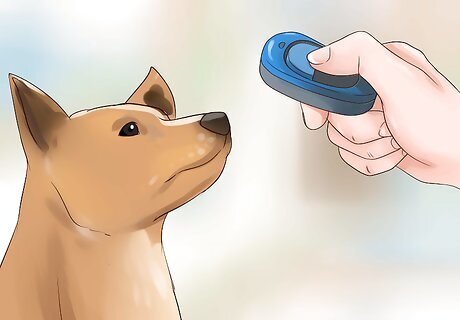
Introduce your dog to the clicker. The clicker should only be used when your dog is behaving the way you want them to, and it should be activated immediately in response to their good behavior. You want your dog to associate their good behavior (in this case, not chasing the cat) with the sound of your clicker.
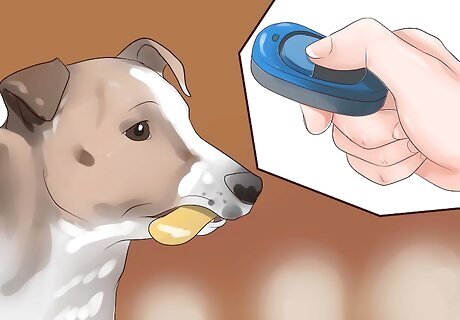
Immediately give them a treat. The final component in clicker training is giving your dog a treat immediately after the click. Response time is imperative, as your dog needs to associate the good behavior with the clicking sound, and the clicking sound with a treat.
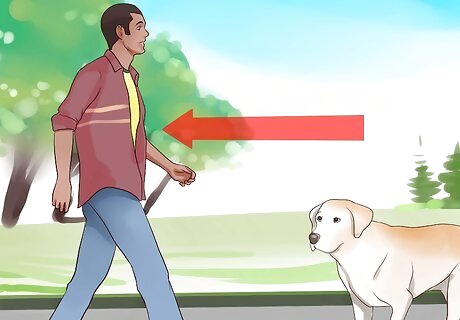
Mimic the cat's movement. As you progress in your training, you may want to gradually incorporate an added challenge wherein you mimic the cat's movement. This will help your dog more easily adjust to the real scenarios that may arise as your dog and cat adjust to one another. While the dog is paying attention to you, begin to suddenly move backwards at a rapid pace. Stop suddenly. If your dog stops and sits rather than chasing you, use the clicker and give them a reward.
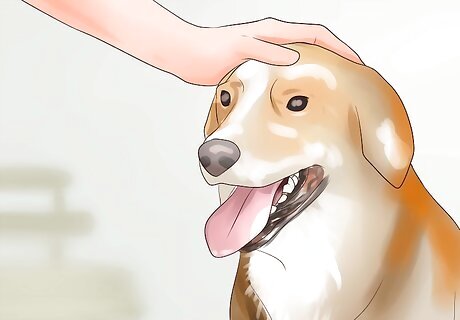
Celebrate your dog's progress. They won't learn a new way to behave overnight. But with time, your dog will learn to complete part of the task you're trying to teach (in this case, not chasing after cats). It's important to reward even partial progress, or steps, towards meeting that goal, because in order to break your dog's instinctual behavior you are, essentially, breaking down the components of that behavior. Any time your dog starts to chase the cat but stops, use the clicker and give them a reward. Eventually, they should be able to break the habit of chasing cats altogether.
Keeping Your Dog from Chasing Neighborhood Cats
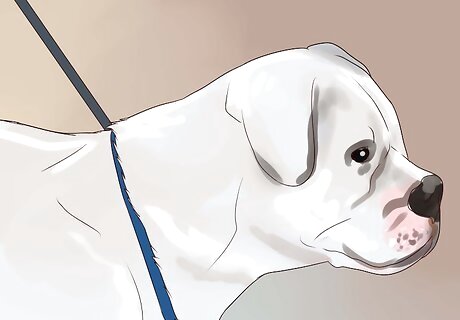
Keep your dog on a leash. If your dog has a tendency to chase cats in your neighborhood, it's best to keep your dog on a leash during walks. If you feel inclined to let your dog off-leash during walks, you should do so only in places where you know there will be no cats around, such as a dog park or a quiet place away from other homes. You should also try to only let your dog off-leash at the park during times when you know there will be no cats around. Remember that cats are most active at dusk and dawn, as they often come out to hunt during the night. Use the "leave it" method on your dog during walks. Even though your dog is on a leash, they may still try to run and pull on the leash whenever they see a cat. Teaching them to leave it when they see a cat will help take the stress out of walking your dog in a cat-friendly neighborhood. If your dog pulls hard or barks while on their leash, they may have what's known as leash aggression. Put simply, the dog perceives that you're anxious about how they'll react to an animal, and they assumes that animal is a threat. To train your dog out of this, practice getting your dog's attention no matter what is happening around you. Reward him when he keeps his eyes on you. Start out in a low-stress environment, such as your home, and gradually work toward keeping your dog focused on you (and on the treat he'll come to expect) no matter what other animals are around on your walk. Another crucial skill to teach your dog if you plan to let them roam off-leash is to come when called. Try teaching your dog to come while you run away from them, as they will almost inevitably chase after you. This will make it easier for them to learn this command early on in their training, as they will associate your praise with their following after you. Reward them with treats and praise whenever they comes on command.
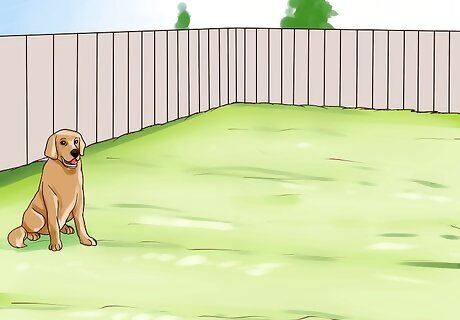
Confine your dog to your yard. If you have a yard at your home and you'd like to let your dog run freely in the yard, be sure that you either erect a fence around your property, or use a tether and leash to keep your dog from leaving your yard. This will help ensure that your dog does not chase any outdoor cats that live in your neighborhood.
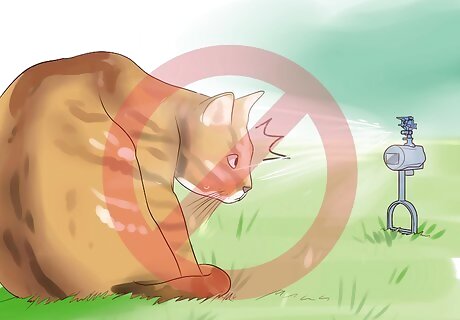
Keep cats out of your yard. If your neighbors have an outdoor cat that tends to get in your yard, the best way to keep your dog from chasing that cat is to keep them out of your yard. You can manually chase the cat away whenever you see them come into your yard, or use motion-activated water sprays along the perimeter of your yard. These devices detect movement and spray the target with water, which can be an excellent deterrent against intruding cats.
Learning When to Get Involved
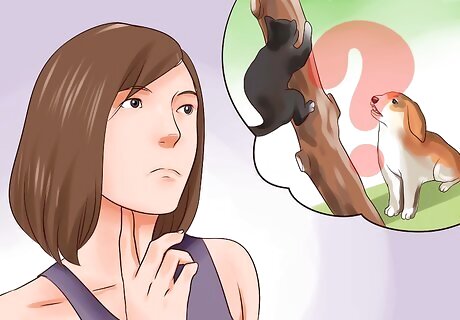
Understand why dogs chase cats. The primary reasons a dog chases cats are because the dog wants to play with the cat (perhaps thinking it's another dog), or because the cat's movement triggers your dog's predator/prey instincts. Both scenarios require you as the owner to step in whenever necessary to prevent the animals from harming one another. Even if your dog is trying to play with the cat, it's possible that they may play too aggressively, and may try to chase or bite the cat as a means of playing with them. If your dog is chasing the cat for predatory reasons, it's even more important for you to step in, as your dog could easily kill your cat, and the cat could seriously injure your dog.
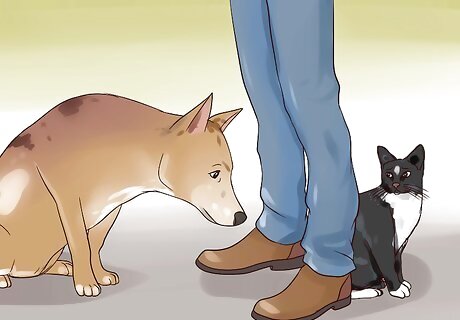
Supervise the animals, always. The training and adjusting period will most likely take a while. Eventually, once your cat and dog have become accustomed to one another, it may be safe to leave the animals alone together unsupervised, but that will take at least a month, most likely longer. The important thing is to ensure that the animals will not harm one another if left alone.
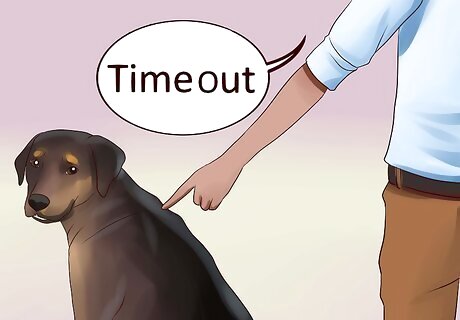
Use timeouts when your dog chases the cat. Any time your dog breaks the training and chases your cat, you may want to consider putting them in a time out. Timeouts should never be harmful to the dog; rather, you simply want to remove them from the situation, letting them know that he behaved badly in that situation. Choose a timeout room, and use that room consistently for timeouts. Someplace isolated, like a bathroom, would work well. But be sure that the room is not uncomfortable. For example, an unheated basement in winter would be a bad timeout location. Likewise, an unventilated or un-air-conditioned room in summer would be a bad timeout location. Calmly say the word, "timeout," when your dog begins to chase the cat. Gently lead your dog by the collar out of the room where they chased the cat and into the chosen timeout room. Wait a short while - about a minute or two should be sufficient - and then calmly release your dog from the timeout room. If they repeats the bad behavior, calmly and promptly return them to the timeout room.
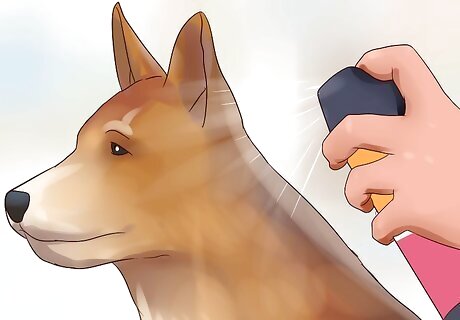
Make cats undesirable for your dog. If none of your training has worked, you may want to make cats less desirable for your dog. This should only be done as a last resort, and should not involve injuring or harming your dog in any way. Experts recommend simply making your dog associate chasing a cat with a mildly unpleasant experience, like an annoying sound or a gentle repulsive spray scent like citrus. Even a spray bottle filled with clean, cold water may be enough to deter your dog. Over time, your dog will come to associate chasing cats with, say, an unpleasant burst of (dog-safe) citrus spray or a quick blast of cold water to the face, and they will no longer wish to chase the cat.
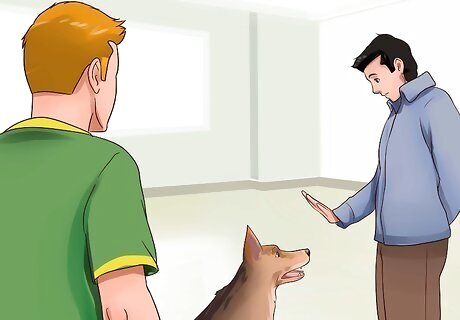
Consider working with a trainer or behaviorist. If nothing else has worked in deterring your dog from chasing the cat, you may want to consider working with a specialist. Make sure that the specialist you work with is certified, such as a certified professional dog trainer (CPDT) or a board-certified veterinary behaviorist. Though it will take many sessions, a certified specialist with education and training in animal behavior will be able to determine what is driving your dog to chase the cat, and what can be done to break them of that habit. You can find CPDTs and board-certified veterinary behaviorists by searching online for a specialist in your area. Make sure you check a specialist's references, and look for online reviews from other dog owners who have worked with that specialist.



















Comments
0 comment